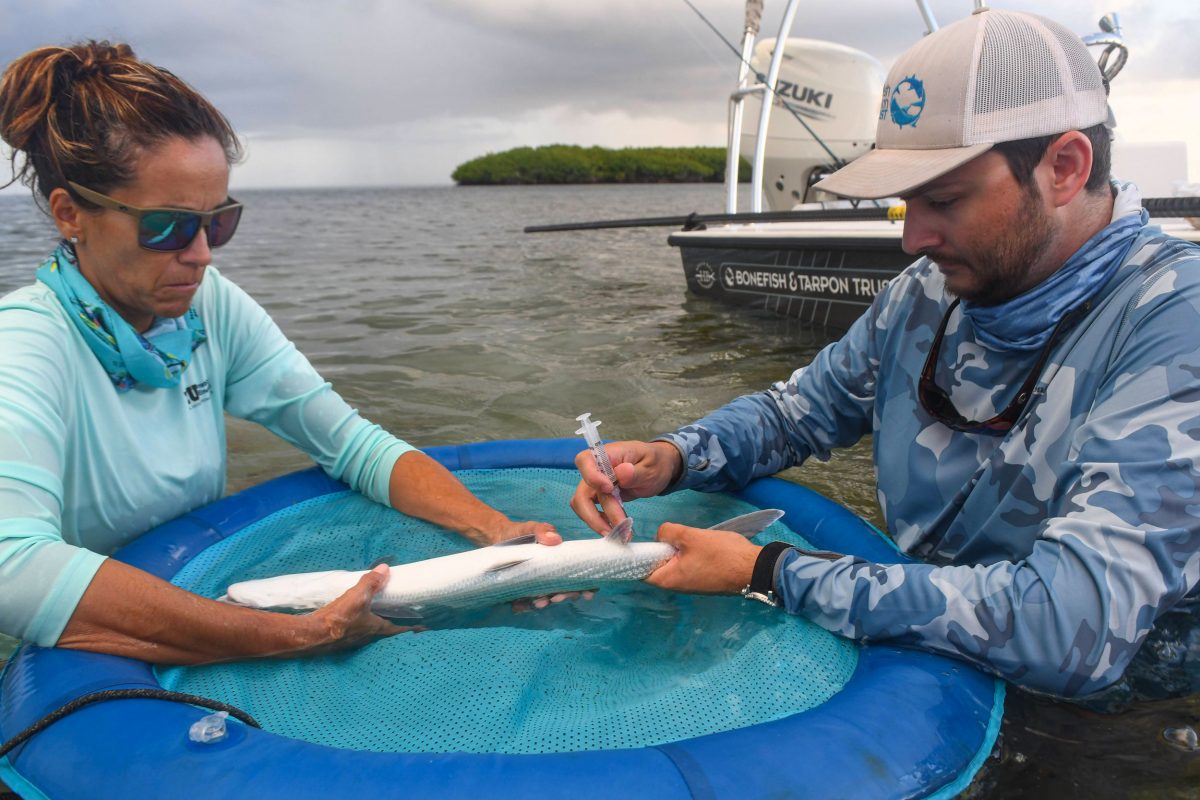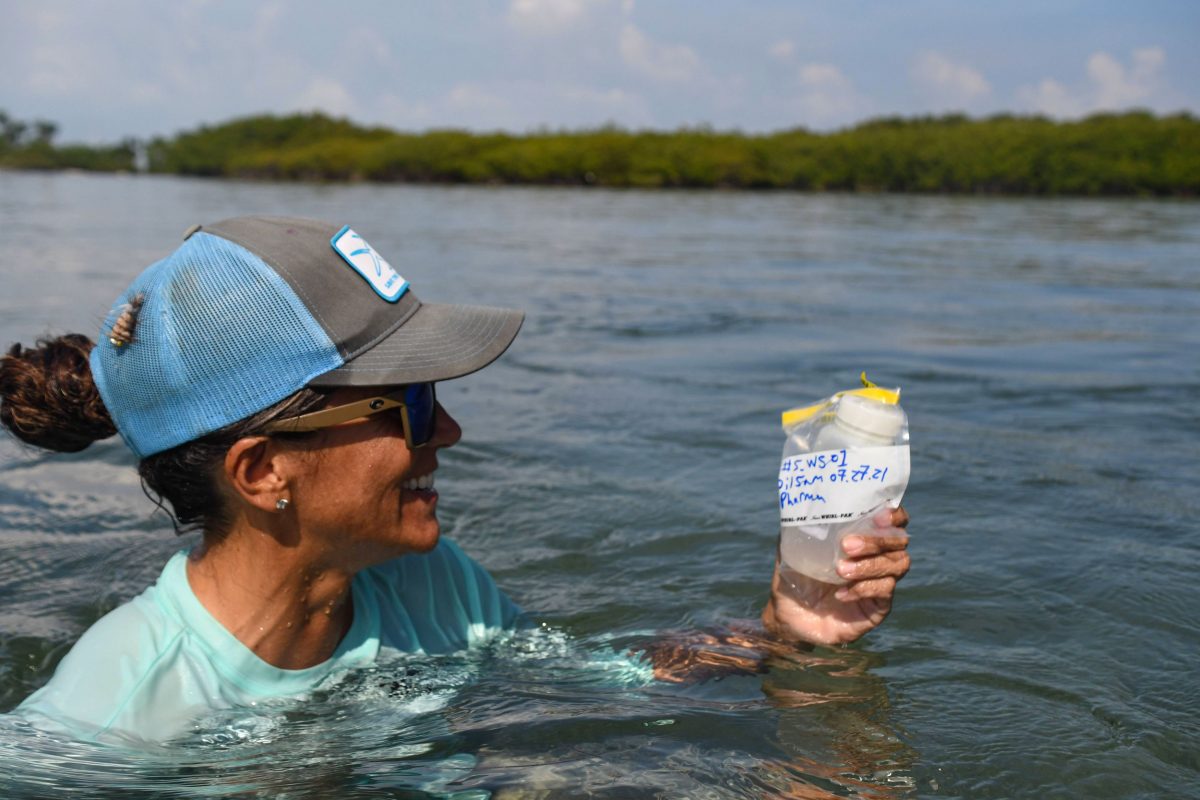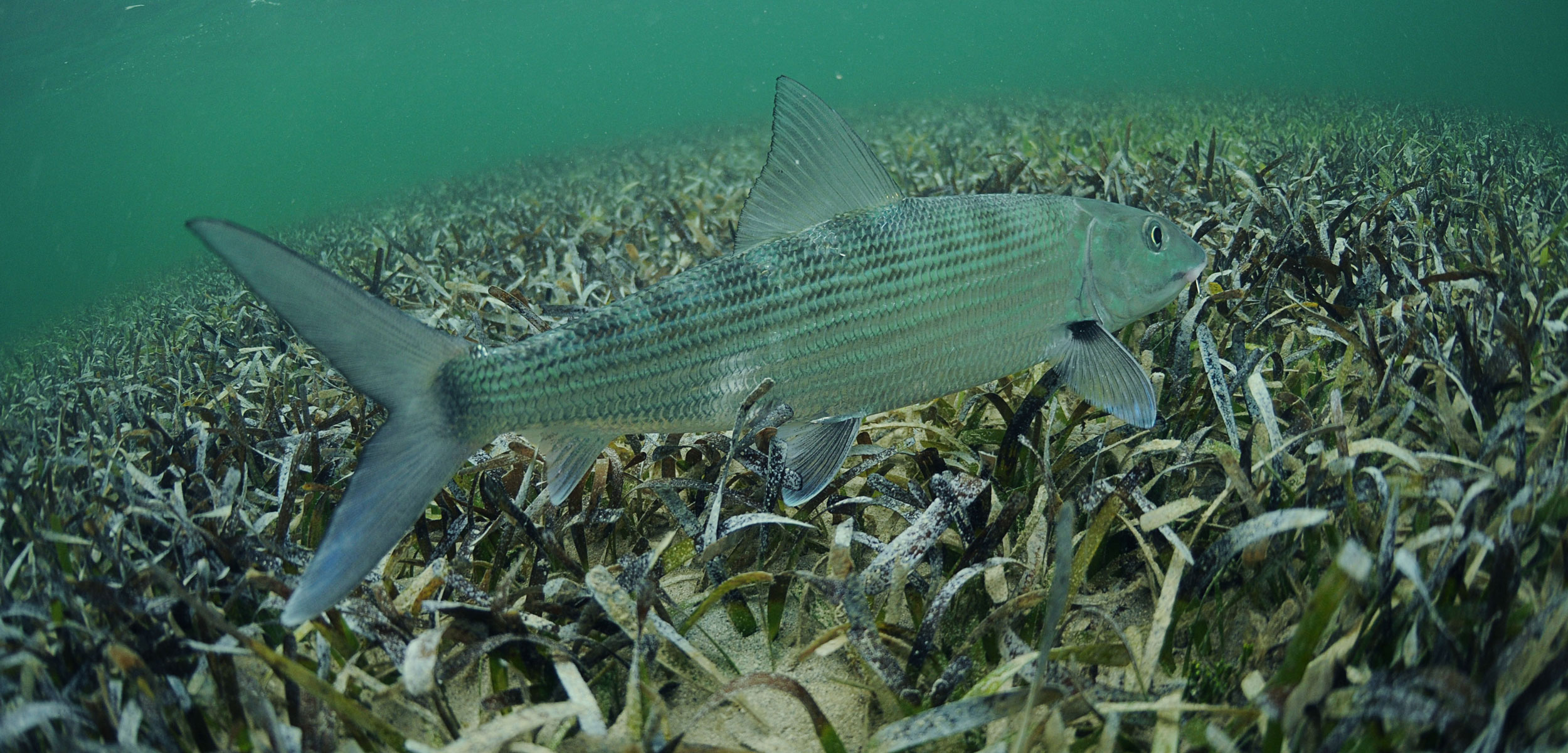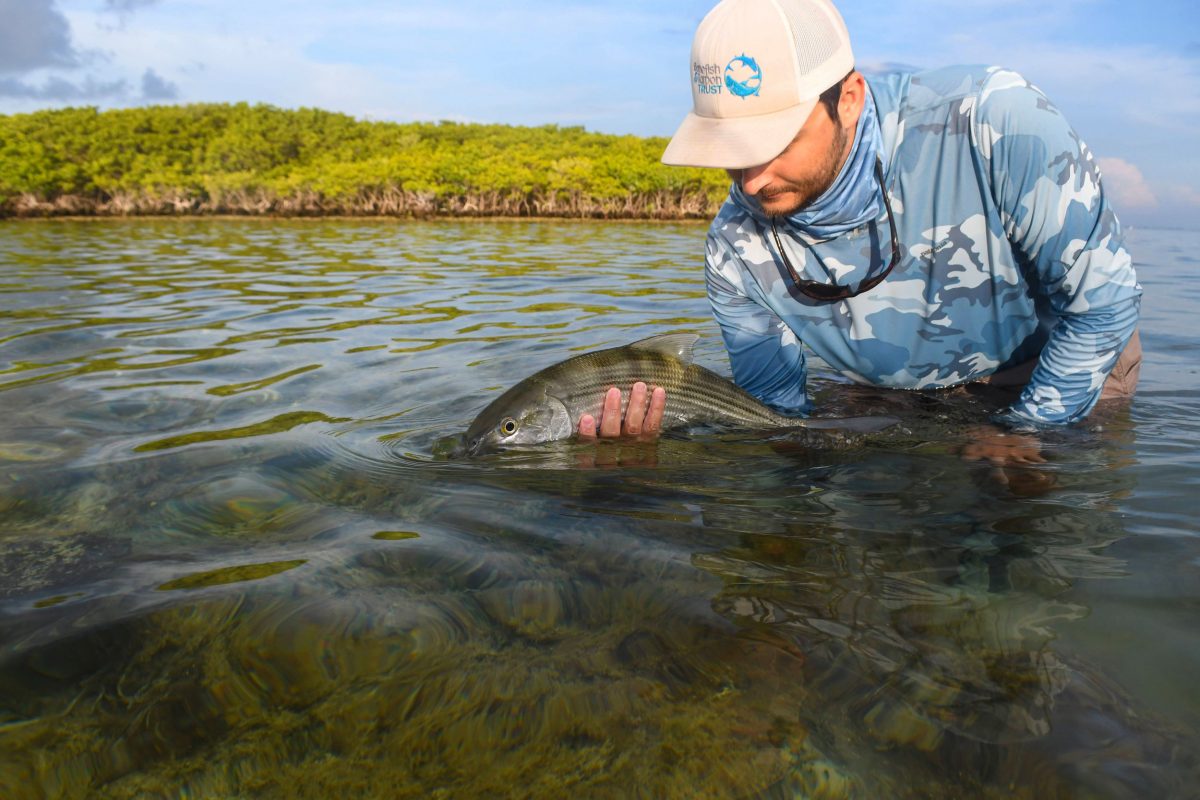The Search for What’s Harming Florida’s Beloved Bonefish
If you think it’s not our fault, urine denial.
Article body copy
A slender forked tail suddenly pokes through the surface of the shallow waters around Biscayne Bay, Florida, some 50 meters in front of where our small skiff is floating. The tail belongs to a bonefish, a skittish and elegant species with an elongated body roughly the length of an adult male’s forearm and so called because of its numerous little bones. The fish is busily using its slim snout to dig in the sediment and seagrass for crabs, shrimp, and other good things to eat. As it does so, the tip of its tail pops up, and Nicholas Castillo, a PhD candidate at Florida International University, calls excitedly, “It’s tailing.”
Jennifer Rehage, a fish ecologist and Castillo’s PhD supervisor, drops anchor near a mangrove island hosting a flock of snowy egrets, their snapping bills loudly clicking. Castillo, who is also an expert fisherman, selects a colorful artificial fly from his kit. He’s got one shot at catching the fish. If he makes a wrong move, the fish will take off at high speed—bonefish can swim up to 64 kilometers per hour. We all climb out of the boat, and I’m instructed to stay nearby and not make a sound. Castillo stealthily wades toward where we saw the tail, then stops and waits. He whips the line back and forth using a fly-fishing cast, then lands the fly expertly on the surface, where it slowly sinks. The bonefish bites on the first cast but fights hard against Castillo’s pull, thrashing and squirming in the water. It takes a minute or so, but in the end Castillo reels the fish in.
Castillo and Rehage are catching bonefish to investigate why the population has plummeted over the past 35 years around South Florida and areas in the Caribbean Sea. South Florida is world renowned for sportfishing, a reputation that was built, in part, on the size and number of bonefish that were once found there. Today, that population is halved and the fish are smaller. Precise numbers of bonefish are not known, but researchers use the average number of bonefish caught by anglers per month as a way of estimating the decline. The bonefish catch fell from a high of over 25 fish in the late 1980s to a low of around five from 2010 onward. Bonefish are having other problems, too. A healthy fish population typically has an equal number of males and females. But in his fieldwork, Castillo has seen many more males than females, and without large females the population produces fewer eggs and larvae, he explains. Castillo also suspects the population’s spawning behavior might be “out of whack.”
Back at the boat, Rehage and Castillo place the fish in a round inflatable pool lounger, a rubber ring with a net attached underneath. The repurposed floatie—perfect for bonefish and for margaritas after fishing, jokes Castillo—safely confines the bonefish while the researchers quickly take measurements and blood and fin samples. The fish is about 45 centimeters long. In the past, fish were twice that size, says Castillo. Rehage flips the fish over to reveal a silvery-scaled belly that helps it hide in the carpets of seagrass and snips off the tip of a fin on the underside of its body. “It doesn’t hurt. It grows back quickly,” she says. She then holds the fish tight upside down while Castillo draws blood. It takes a few attempts to find the vein, but at last the syringe fills with rich red blood, and Rehage returns the fish to the floatie to chill out and recover. Before releasing it, Rehage and Castillo scan for predators like lemon or blacktip sharks that would make an easy meal of a bonefish that has just been caught, measured, and poked. Satisfied that the coast is clear, Castillo lets the fish go, and it nonchalantly swims away.

Biologists Jennifer Rehage and Nicholas Castillo, both from Florida International University, take a blood sample from a bonefish in the shallows of Biscayne Bay, Florida. Photo by Natasha Gilbert
The bonefish samples add to the others Rehage and Castillo have collected from over the past three years from South Florida and other nearby locations including the Bahamas and the Caribbean. The duo is also sampling the water, sediment, and bonefish prey animals, searching for clues that can explain the bonefish’s demise. Recently, they’ve begun to suspect pharmaceuticals. Could the medications used to treat people on land be harming the fish in the water? By sampling over 130 fish, the team hopes to help the whole bonefish population keep its head above water.
Bonefish are wary and speedy creatures which makes them a challenge to catch and popular with sport fishers. (A 2012 assessment found that sportfishing for bonefish and other species in the shallow waters around South Florida helped bring in over US $450-million to the state’s economy.) When bonefish started disappearing from around South Florida over 25 years ago, it was sport fishers and fishing guides who first noticed. Aaron Adams, now director of science at the Bonefish and Tarpon Trust (BTT), a Miami, Florida–based conservation group, also spotted the decline. “It was pretty obvious. Bonefish became almost impossible to catch,” he says.
BTT, originally established by a small group of sport fishers in 1997, aims to fill large gaps in scientific knowledge about bonefish health and ecology as well as threats to their survival. About five years ago, BTT asked Rehage to investigate what was up with South Florida’s bonefish population.
Several species of bonefish are found around the world, and the South Florida population isn’t the only one that is struggling. Pacific Ocean species near the Cook Islands and in Hawai‘i are also in trouble, and bonefish population declines prompted the bonefish’s inclusion on the International Union for Conservation of Nature’s Red List of Threatened Species. But the species that Castillo and Rehage are investigating, Albula vulpes, is particularly vulnerable. This is partly because it dwells in a small range limited to the Caribbean Sea and the western Atlantic Ocean around the Bahamas and South Florida, explains Adams, who says he’s been “a pretty hardcore fisherman” since childhood. Growing up, Adams caught fish in the Chesapeake Bay, sometimes skipping school to indulge his passion. Over time, he saw the habitat he loved destroyed and the fish populations decline. “As I grew up, the bay ecosystem was collapsing,” he says. This experience prompted him to study fish biology and ecology to help find ways to conserve and manage fish species, he says. He joined BTT in 2006. If Rehage and Castillo can solve what is troubling bonefish, it might also improve the ecosystem for other species, says Adams.
When Rehage started to investigate the cause of the bonefish decline, her main challenge was the number of options South Florida presented: urban development, agricultural runoff, and habitat destruction are rife in the area, which includes Miami, one of the most densely populated cities in the United States. She began by looking to see if pollutants like agricultural pesticides or copper were to blame. But one thing she hadn’t considered was prescription medications. An impromptu chinwag over beers at a research conference with a scientist who’d found that salmon are harmed by antidepressants prompted Rehage to consider if pharmaceuticals were involved, she says.
Prescription drugs enter the ecosystem through flushing urine and unused drugs down the drain. Wastewater treatment usually doesn’t remove pharmaceutical compounds effectively, so cocktails of drugs from opioids to antidepressants can end up in rivers and the ocean. And with such a large population packed into a small area, South Florida sees high concentrations of medicines wash into the environment. As well, the area’s wastewater infrastructure is old and decrepit. Broken pipes often spew sewage into coastal areas, and recent upgrades are only just connecting some homes that have old, leaky septic tanks to the city’s sewer system. Some of the municipal sewage is now injected deep underground. But the area’s porous limestone rock allows sewage to leak out into the ocean, says Adams.
Scientists know less about how pharmaceutical pollution affects the marine environment than they know about how it affects freshwater ecosystems. Many presumed that the large volumes of seawater could dilute the drugs, rendering them harmless, but Rehage and Castillo found this isn’t the case for bonefish in their study area.
In what is one of the most comprehensive studies of its kind, the duo found high levels of 58 different types of pharmaceuticals, including heart medication, antidepressants, and antibiotics in the fish they caught. Every fish they sampled had at least one compound in its blood and some had up to 17 different drugs. Over half of the 93 fish sampled from South Florida had concentrations of pharmaceuticals above levels considered safe for wildlife. The researchers also found that bonefish prey animals are likewise riddled with drugs, with evidence of 61 different types of pharmaceuticals. Mixtures of so many different drugs could cause serious harm to wildlife, they say. “A yummy crab is a healthy serving of pharmaceuticals,” says Castillo. Rehage and Castillo say the results point to pharmaceutical pollution as an important driver of the bonefish demise. “There is compelling evidence linking drug pollution to bonefish decline,” says Rehage.

Rehage takes a water sample, which will be tested for the presence of pharmaceuticals. Photo by Natasha Gilbert
But while the researchers are confident that pharmaceuticals are part of the problem, they still need to work out the specifics of how the chemicals do harm. Drugs can mess with fish by changing behaviors that are key to their survival like migration and avoiding predators. Studies show that Atlantic salmon exposed to anti-anxiety medication swim faster when they migrate, for instance, potentially taking more risks and making them more likely to become prey. Castillo suspects something similar might be happening with bonefish. He wonders if the drugs are interfering with bonefish spawning behavior.
Healthy bonefish populations, such as those in the Bahamas, gather in large groups of over 1,000 fish before they migrate to spawn. But researchers haven’t seen the South Florida population doing the same thing. Castillo doubts the fish are breeding at all. This makes him worry about a recent noticeable yet unexplained comeback of some bonefish in the area. Castillo suspects they are coming in from healthy populations elsewhere, perhaps from Cuba, Belize, or Mexico.
But without identifying and fixing the problem behind the decline, the returning bonefish may disappear as suddenly as they showed up, says Adams. “We might be in a lucky period. We’re waiting for the other shoe to drop,” he says.
Rehage and Castillo hope to further investigate the decline and possible impacts on spawning behavior in a future project. They are considering a new technique that involves implanting pharmaceuticals into the fish’s body that slowly release over time. This mimics how fish are exposed to drugs in the wild. The researchers can then track the fish to see how the drugs affect their behavior and survival.

Bonefish are sometimes called the gray ghost because of their silvery coloration but also for their stealth and speed—they often appear out of nowhere and vanish just as quickly. Photo by Beth Swanson/Alamy Stock Photo
Rehage and Castillo presented their results to Florida State leaders and policymakers on February 2. BTT hopes the research will push policymakers to expand wastewater treatment plants around South Florida and convert more homes away from old septic tank systems. These improvements will help clean up the area’s drug pollution problem, but other challenges the bonefish face may prove harder to fix.
As we motor back toward the dock, people on jet skis fly by at a carelessly high and illegal speed. The jet skis can damage the delicate seagrass on which the fish depend. “I hate jet skis,” growls Castillo as he calls the coast guard to report the incident. A little farther on, we idle past a boat with its propeller tangled up in seagrass. The driver rips up clumps as he struggles to free the boat. He likely got stuck going too fast in an area clearly marked as a “no wake zone,” which boaters should avoid or navigate through at a very slow speed. I think back to the bonefish we caught and the care with which Castillo and Rehage handled and released it. Next time it’s caught, will it be so lucky?


